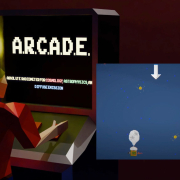UMD Students Win First Place at hackUMBC 2025 Game Jamathon
A team of University of Maryland Department of Computer Science and Immersive Media Design (IMD) students won first place at the Game Jam held during hackUMBC 2025 on September 27 and 28. Hosted by the University of Maryland, Baltimore County, the 24-hour competition brought together 35 teams, challenged to create a fully playable video game from scratch. The UMD team’s entry, "A.R.C.A.D.E", inspired by a NASA project that used weather balloons to detect cosmic radiation, stood out for its completeness in both design and execution.
The team included senior computer science majors Declan Scott and Samuel Wiggins, who is also pursuing a second major in the IMD B.S. track, along with IMD B.A. track seniors Kadan Knapp and Daryn Rowse.
Creating Under Pressure
 The competition’s theme, “Arcade,” gave teams broad creative freedom. Many participants reimagined traditional arcade settings or retro gameplay, but the UMD team decided to interpret the theme differently.
The competition’s theme, “Arcade,” gave teams broad creative freedom. Many participants reimagined traditional arcade settings or retro gameplay, but the UMD team decided to interpret the theme differently.
They found inspiration in an obscure NASA acronym that referred to a balloon-based cosmic radiation experiment. From that, they built a game centered on designing custom ships lifted by weather balloons to see how far they could travel into the atmosphere.
Before starting, the team spent several hours outlining their ideas on a whiteboard and dividing tasks. Scott and Wiggins handled programming, Knapp developed artwork and 3D models and Rowse composed original music and sound. Working nonstop without sleep, they faced the challenge of managing fatigue while staying coordinated.
“It got really draining around 4 a.m., but we pushed through,” Scott said. “Having each other there made it easier to keep going and stay focused.”
Building a Complete Game
Many teams at the event focused on coding mechanics, but the UMD students aimed to produce a game that looked, sounded and felt complete. That decision became one of their biggest advantages.
“One of the judges told us our game stood out because it was cohesive,” Scott said. “A lot of teams had great mechanics, but not much art or sound. We had all of that working together.”
Their final submission featured interactive gameplay, pixel art visuals and an original soundtrack—all developed within the 24-hour time frame. Wiggins said his background in both computer science and design helped connect the technical and creative sides of the project.
“I wrote scripts for object spawning and collisions but also worked to integrate the art and music so everything felt unified,” he said.
Lessons from the Experience
The win was a surprise, Scott said, since it was their first time competing in an in-person Game Jamathon.
“We didn’t know what to expect going in, but hearing we had won was really exciting,” he said.
Beyond the recognition, the experience highlighted the teamwork and adaptability needed to complete a large project under tight deadlines. The group’s planning and skill balance allowed them to finish a playable game, while many other teams struggled to complete theirs.
Wiggins said the experience gave him a new perspective on project completion.
“Not all my projects have reached a polished state before,” he said. “Seeing this one come together showed me I can take an idea from concept to completion.”
Skills from the Classroom
Scott credited his computer science coursework with helping him think critically under pressure. He said classes in the department have taught him to approach projects efficiently, especially when time is limited.
“In a 24-hour competition, you don’t have time to overcomplicate things,” he said. “You have to figure out how to build something that works right away and can still support whatever else you need to add later. That’s a skill I’ve developed through my CS classes.”
Moving Forward
The group’s success boosted their confidence for future competitions and projects. They plan to continue developing games that draw on scientific ideas and creative storytelling.
“The competition showed us what’s possible when you combine different strengths and work toward a clear goal,” Scott said.
For the team, the win was more than an award, it was proof of how collaboration and classroom skills can translate into real creative achievements. Their success also highlights the growing intersection between computer science and immersive media design at the University of Maryland, where students continue to explore how technical and artistic disciplines can work together to create interactive experiences.
—Story by Samuel Malede Zewdu, CS Communications
###
The Immersive Media Design program at the University of Maryland is a four-year, cross-disciplinary program that equips students with skills in digital creativity and innovation using modern immersive media tools and techniques. Students can choose between a Bachelor of Arts in Emerging Creatives, which emphasizes artistic and design aspects, or a Bachelor of Science in Computing, which focuses on the technical side of immersive media.
The Department welcomes comments, suggestions and corrections. Send email to editor [-at-] cs [dot] umd [dot] edu.
